Analysis of Leadership and Management Roles at Tesco
VerifiedAdded on 2020/10/23
|16
|5409
|410
Report
AI Summary
This report provides a detailed analysis of leadership and management within Tesco, a leading retail organization. It begins by differentiating the roles and characteristics of leaders and managers, exploring various leadership styles such as autocratic, democratic, and strategic leadership. The report then delves into the application of Henri Fayol's functions of management and examines leadership and management roles in different situational contexts, including crisis management. Furthermore, it explores the application of leadership theories like systems and situational leadership within Tesco. The report also addresses key approaches to operations management and its impact on achieving business objectives, including factors influencing business operations and the wider business environment, such as corporate social responsibility and sustainability. The analysis provides insights into how leadership and management practices influence Tesco's operations and its ability to achieve its goals.
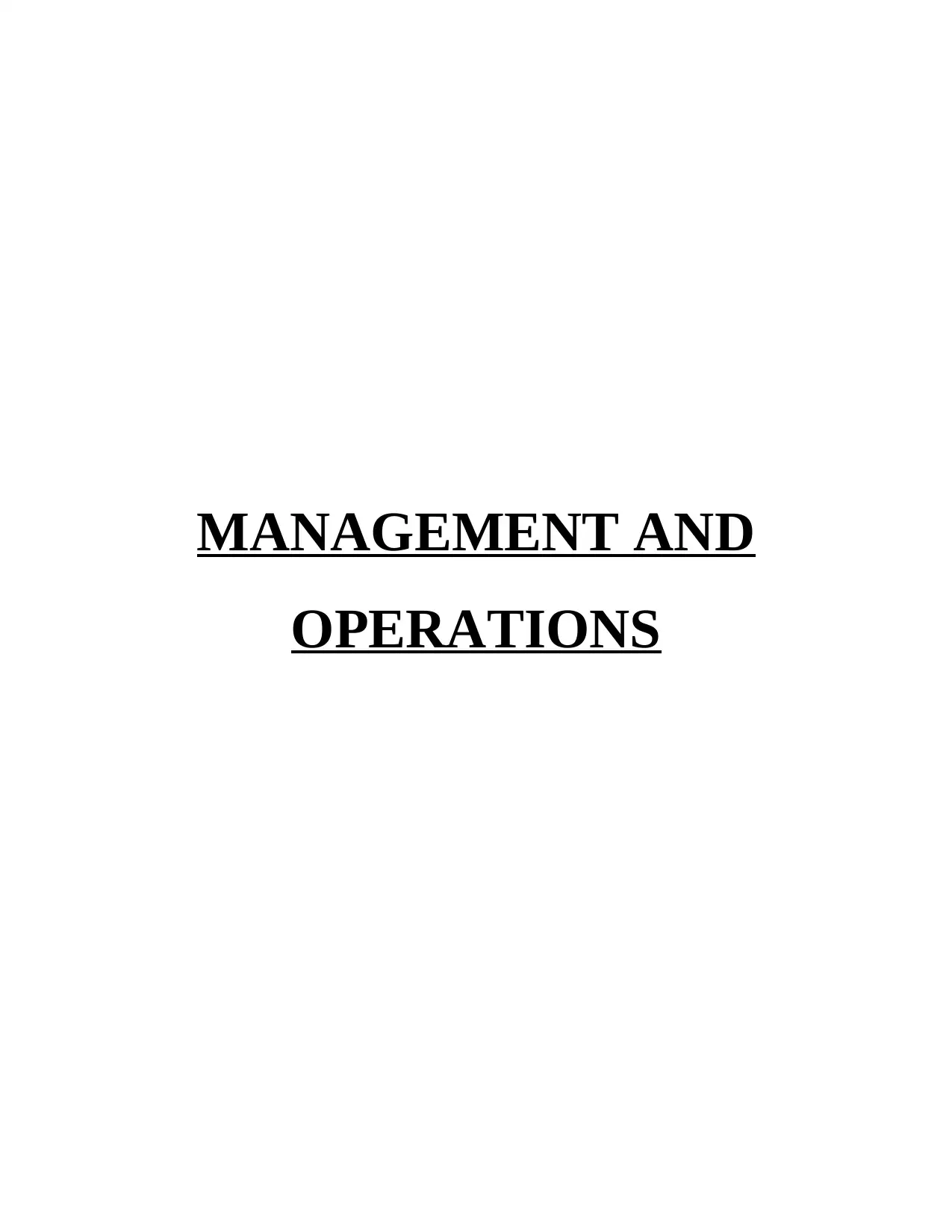
MANAGEMENT AND
OPERATIONS
OPERATIONS
Paraphrase This Document
Need a fresh take? Get an instant paraphrase of this document with our AI Paraphraser
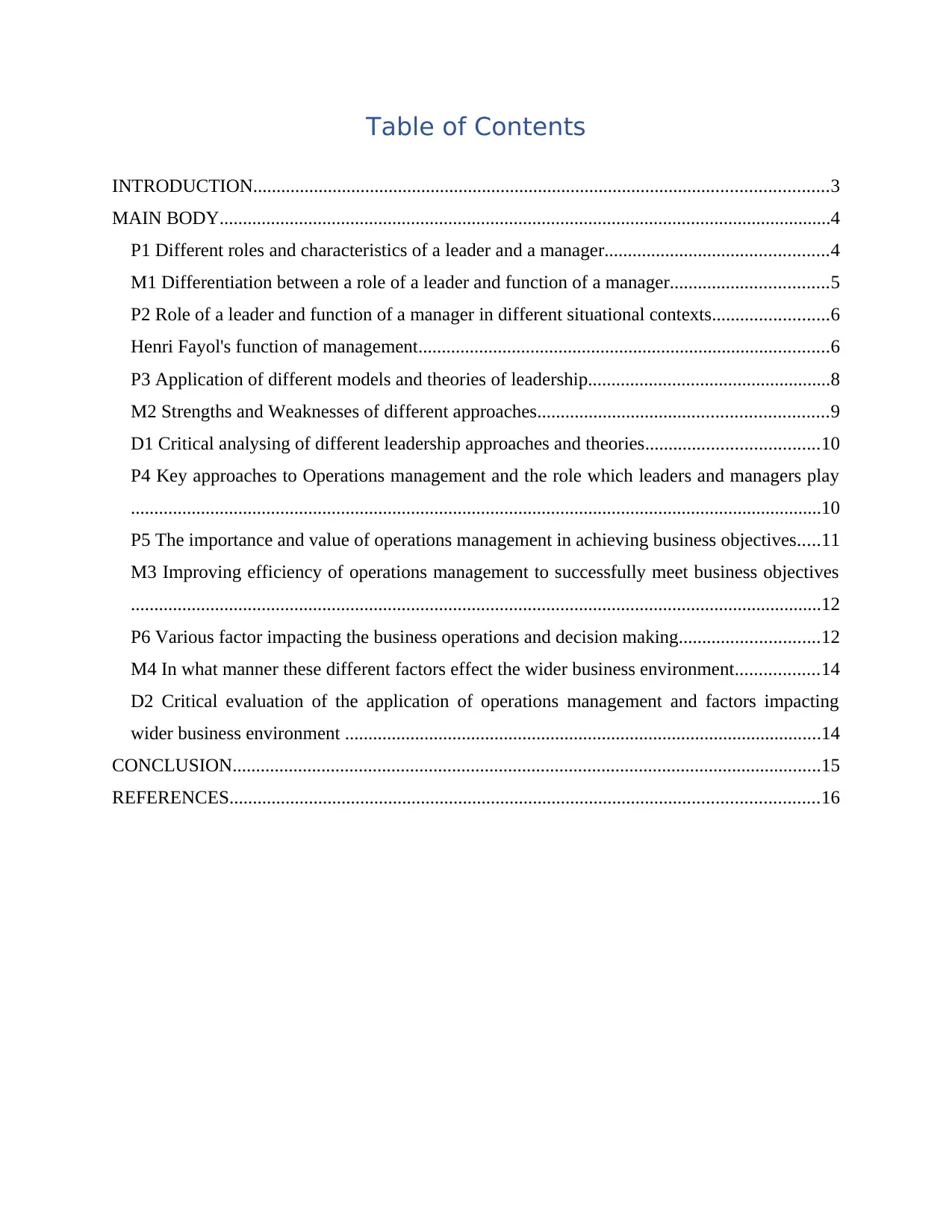
Table of Contents
INTRODUCTION...........................................................................................................................3
MAIN BODY...................................................................................................................................4
P1 Different roles and characteristics of a leader and a manager................................................4
M1 Differentiation between a role of a leader and function of a manager..................................5
P2 Role of a leader and function of a manager in different situational contexts.........................6
Henri Fayol's function of management........................................................................................6
P3 Application of different models and theories of leadership....................................................8
M2 Strengths and Weaknesses of different approaches..............................................................9
D1 Critical analysing of different leadership approaches and theories.....................................10
P4 Key approaches to Operations management and the role which leaders and managers play
....................................................................................................................................................10
P5 The importance and value of operations management in achieving business objectives.....11
M3 Improving efficiency of operations management to successfully meet business objectives
....................................................................................................................................................12
P6 Various factor impacting the business operations and decision making..............................12
M4 In what manner these different factors effect the wider business environment..................14
D2 Critical evaluation of the application of operations management and factors impacting
wider business environment ......................................................................................................14
CONCLUSION..............................................................................................................................15
REFERENCES..............................................................................................................................16
INTRODUCTION...........................................................................................................................3
MAIN BODY...................................................................................................................................4
P1 Different roles and characteristics of a leader and a manager................................................4
M1 Differentiation between a role of a leader and function of a manager..................................5
P2 Role of a leader and function of a manager in different situational contexts.........................6
Henri Fayol's function of management........................................................................................6
P3 Application of different models and theories of leadership....................................................8
M2 Strengths and Weaknesses of different approaches..............................................................9
D1 Critical analysing of different leadership approaches and theories.....................................10
P4 Key approaches to Operations management and the role which leaders and managers play
....................................................................................................................................................10
P5 The importance and value of operations management in achieving business objectives.....11
M3 Improving efficiency of operations management to successfully meet business objectives
....................................................................................................................................................12
P6 Various factor impacting the business operations and decision making..............................12
M4 In what manner these different factors effect the wider business environment..................14
D2 Critical evaluation of the application of operations management and factors impacting
wider business environment ......................................................................................................14
CONCLUSION..............................................................................................................................15
REFERENCES..............................................................................................................................16
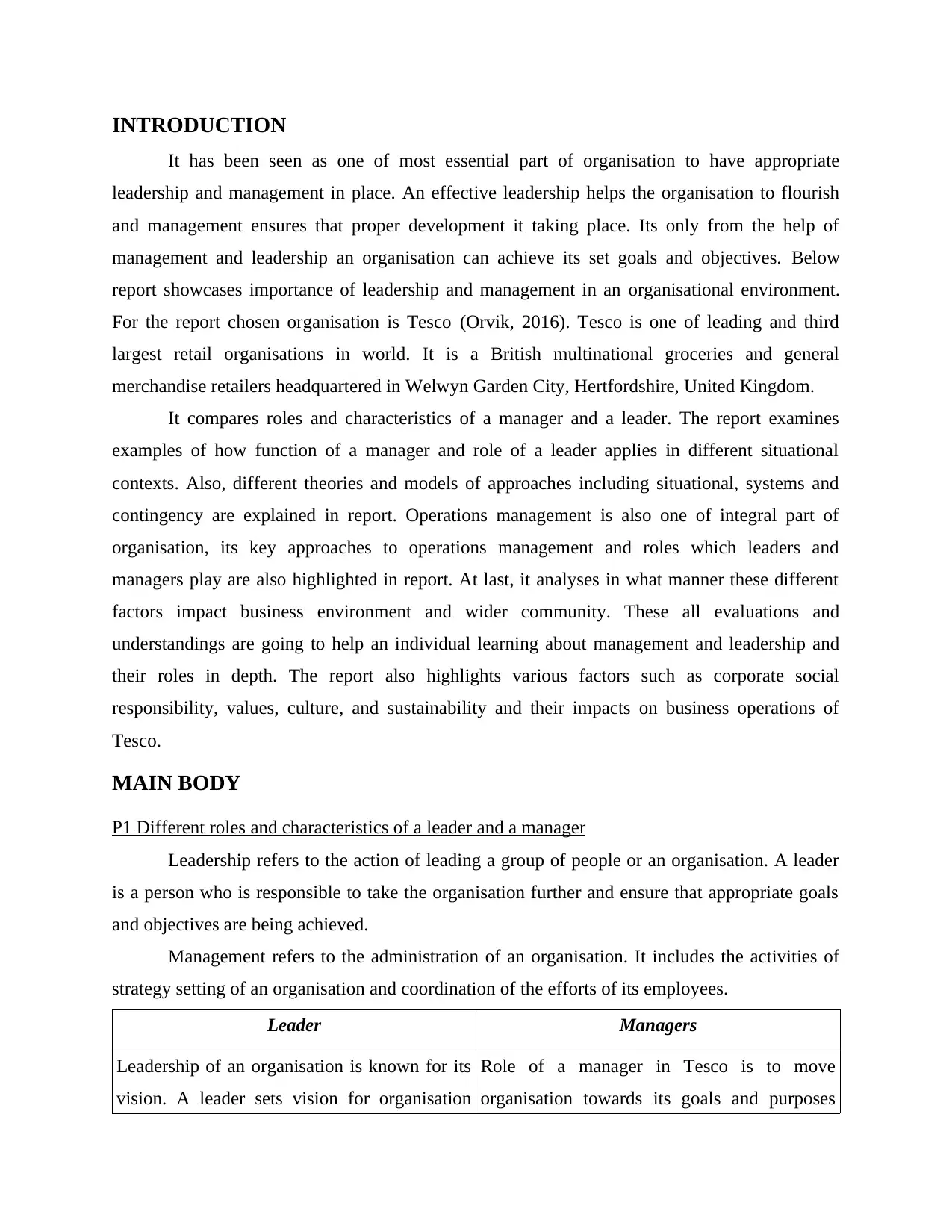
INTRODUCTION
It has been seen as one of most essential part of organisation to have appropriate
leadership and management in place. An effective leadership helps the organisation to flourish
and management ensures that proper development it taking place. Its only from the help of
management and leadership an organisation can achieve its set goals and objectives. Below
report showcases importance of leadership and management in an organisational environment.
For the report chosen organisation is Tesco (Orvik, 2016). Tesco is one of leading and third
largest retail organisations in world. It is a British multinational groceries and general
merchandise retailers headquartered in Welwyn Garden City, Hertfordshire, United Kingdom.
It compares roles and characteristics of a manager and a leader. The report examines
examples of how function of a manager and role of a leader applies in different situational
contexts. Also, different theories and models of approaches including situational, systems and
contingency are explained in report. Operations management is also one of integral part of
organisation, its key approaches to operations management and roles which leaders and
managers play are also highlighted in report. At last, it analyses in what manner these different
factors impact business environment and wider community. These all evaluations and
understandings are going to help an individual learning about management and leadership and
their roles in depth. The report also highlights various factors such as corporate social
responsibility, values, culture, and sustainability and their impacts on business operations of
Tesco.
MAIN BODY
P1 Different roles and characteristics of a leader and a manager
Leadership refers to the action of leading a group of people or an organisation. A leader
is a person who is responsible to take the organisation further and ensure that appropriate goals
and objectives are being achieved.
Management refers to the administration of an organisation. It includes the activities of
strategy setting of an organisation and coordination of the efforts of its employees.
Leader Managers
Leadership of an organisation is known for its
vision. A leader sets vision for organisation
Role of a manager in Tesco is to move
organisation towards its goals and purposes
It has been seen as one of most essential part of organisation to have appropriate
leadership and management in place. An effective leadership helps the organisation to flourish
and management ensures that proper development it taking place. Its only from the help of
management and leadership an organisation can achieve its set goals and objectives. Below
report showcases importance of leadership and management in an organisational environment.
For the report chosen organisation is Tesco (Orvik, 2016). Tesco is one of leading and third
largest retail organisations in world. It is a British multinational groceries and general
merchandise retailers headquartered in Welwyn Garden City, Hertfordshire, United Kingdom.
It compares roles and characteristics of a manager and a leader. The report examines
examples of how function of a manager and role of a leader applies in different situational
contexts. Also, different theories and models of approaches including situational, systems and
contingency are explained in report. Operations management is also one of integral part of
organisation, its key approaches to operations management and roles which leaders and
managers play are also highlighted in report. At last, it analyses in what manner these different
factors impact business environment and wider community. These all evaluations and
understandings are going to help an individual learning about management and leadership and
their roles in depth. The report also highlights various factors such as corporate social
responsibility, values, culture, and sustainability and their impacts on business operations of
Tesco.
MAIN BODY
P1 Different roles and characteristics of a leader and a manager
Leadership refers to the action of leading a group of people or an organisation. A leader
is a person who is responsible to take the organisation further and ensure that appropriate goals
and objectives are being achieved.
Management refers to the administration of an organisation. It includes the activities of
strategy setting of an organisation and coordination of the efforts of its employees.
Leader Managers
Leadership of an organisation is known for its
vision. A leader sets vision for organisation
Role of a manager in Tesco is to move
organisation towards its goals and purposes
⊘ This is a preview!⊘
Do you want full access?
Subscribe today to unlock all pages.

Trusted by 1+ million students worldwide
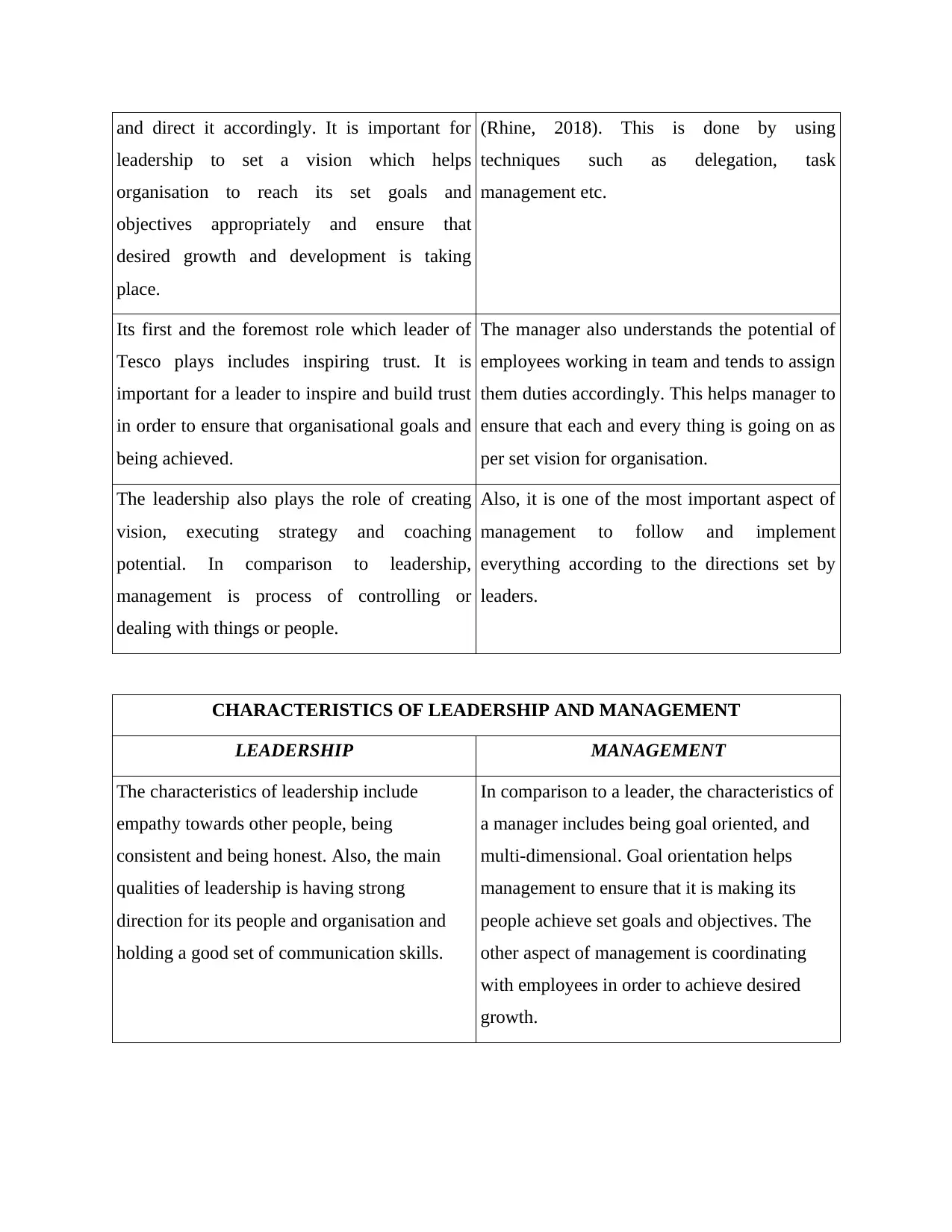
and direct it accordingly. It is important for
leadership to set a vision which helps
organisation to reach its set goals and
objectives appropriately and ensure that
desired growth and development is taking
place.
(Rhine, 2018). This is done by using
techniques such as delegation, task
management etc.
Its first and the foremost role which leader of
Tesco plays includes inspiring trust. It is
important for a leader to inspire and build trust
in order to ensure that organisational goals and
being achieved.
The manager also understands the potential of
employees working in team and tends to assign
them duties accordingly. This helps manager to
ensure that each and every thing is going on as
per set vision for organisation.
The leadership also plays the role of creating
vision, executing strategy and coaching
potential. In comparison to leadership,
management is process of controlling or
dealing with things or people.
Also, it is one of the most important aspect of
management to follow and implement
everything according to the directions set by
leaders.
CHARACTERISTICS OF LEADERSHIP AND MANAGEMENT
LEADERSHIP MANAGEMENT
The characteristics of leadership include
empathy towards other people, being
consistent and being honest. Also, the main
qualities of leadership is having strong
direction for its people and organisation and
holding a good set of communication skills.
In comparison to a leader, the characteristics of
a manager includes being goal oriented, and
multi-dimensional. Goal orientation helps
management to ensure that it is making its
people achieve set goals and objectives. The
other aspect of management is coordinating
with employees in order to achieve desired
growth.
leadership to set a vision which helps
organisation to reach its set goals and
objectives appropriately and ensure that
desired growth and development is taking
place.
(Rhine, 2018). This is done by using
techniques such as delegation, task
management etc.
Its first and the foremost role which leader of
Tesco plays includes inspiring trust. It is
important for a leader to inspire and build trust
in order to ensure that organisational goals and
being achieved.
The manager also understands the potential of
employees working in team and tends to assign
them duties accordingly. This helps manager to
ensure that each and every thing is going on as
per set vision for organisation.
The leadership also plays the role of creating
vision, executing strategy and coaching
potential. In comparison to leadership,
management is process of controlling or
dealing with things or people.
Also, it is one of the most important aspect of
management to follow and implement
everything according to the directions set by
leaders.
CHARACTERISTICS OF LEADERSHIP AND MANAGEMENT
LEADERSHIP MANAGEMENT
The characteristics of leadership include
empathy towards other people, being
consistent and being honest. Also, the main
qualities of leadership is having strong
direction for its people and organisation and
holding a good set of communication skills.
In comparison to a leader, the characteristics of
a manager includes being goal oriented, and
multi-dimensional. Goal orientation helps
management to ensure that it is making its
people achieve set goals and objectives. The
other aspect of management is coordinating
with employees in order to achieve desired
growth.
Paraphrase This Document
Need a fresh take? Get an instant paraphrase of this document with our AI Paraphraser
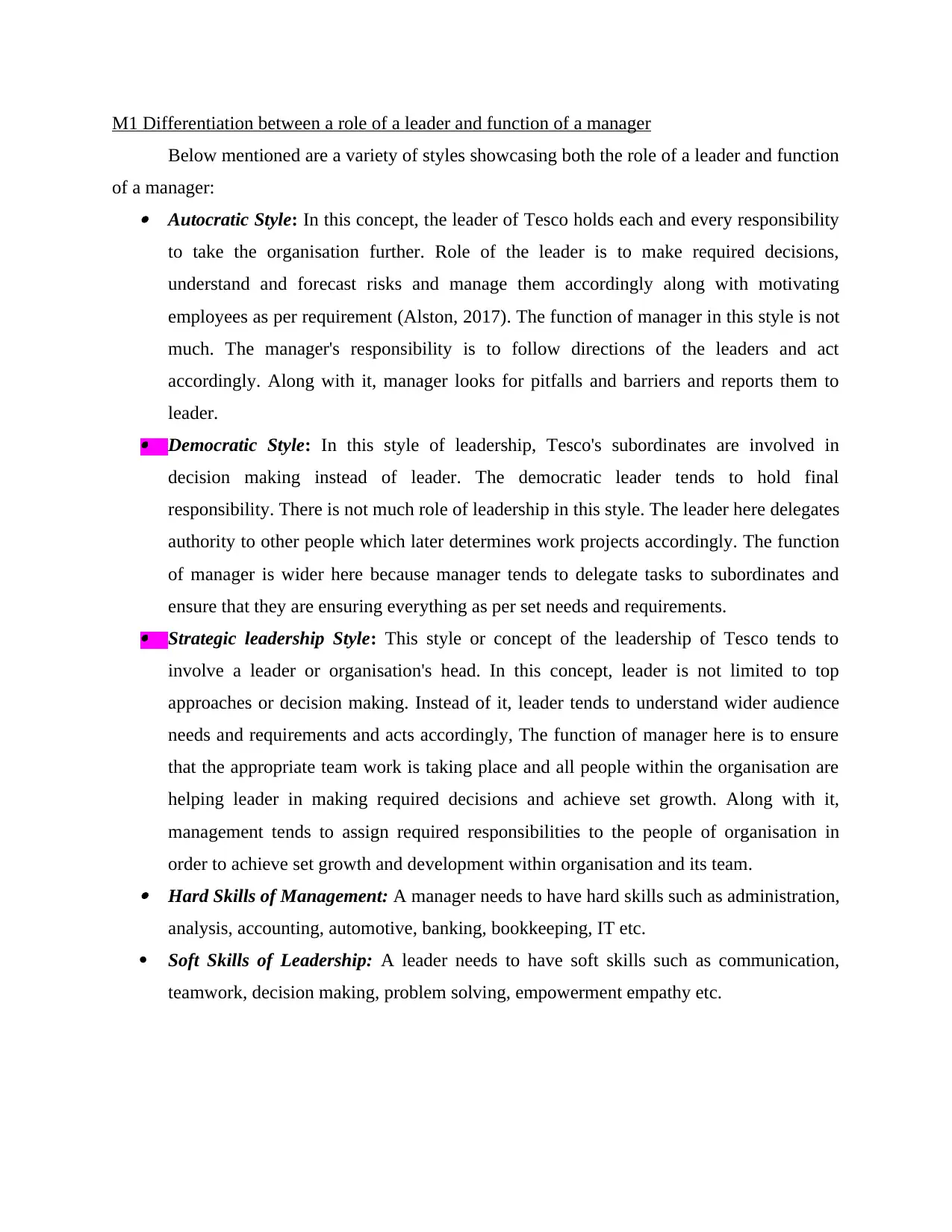
M1 Differentiation between a role of a leader and function of a manager
Below mentioned are a variety of styles showcasing both the role of a leader and function
of a manager: Autocratic Style: In this concept, the leader of Tesco holds each and every responsibility
to take the organisation further. Role of the leader is to make required decisions,
understand and forecast risks and manage them accordingly along with motivating
employees as per requirement (Alston, 2017). The function of manager in this style is not
much. The manager's responsibility is to follow directions of the leaders and act
accordingly. Along with it, manager looks for pitfalls and barriers and reports them to
leader. Democratic Style: In this style of leadership, Tesco's subordinates are involved in
decision making instead of leader. The democratic leader tends to hold final
responsibility. There is not much role of leadership in this style. The leader here delegates
authority to other people which later determines work projects accordingly. The function
of manager is wider here because manager tends to delegate tasks to subordinates and
ensure that they are ensuring everything as per set needs and requirements. Strategic leadership Style: This style or concept of the leadership of Tesco tends to
involve a leader or organisation's head. In this concept, leader is not limited to top
approaches or decision making. Instead of it, leader tends to understand wider audience
needs and requirements and acts accordingly, The function of manager here is to ensure
that the appropriate team work is taking place and all people within the organisation are
helping leader in making required decisions and achieve set growth. Along with it,
management tends to assign required responsibilities to the people of organisation in
order to achieve set growth and development within organisation and its team. Hard Skills of Management: A manager needs to have hard skills such as administration,
analysis, accounting, automotive, banking, bookkeeping, IT etc.
Soft Skills of Leadership: A leader needs to have soft skills such as communication,
teamwork, decision making, problem solving, empowerment empathy etc.
Below mentioned are a variety of styles showcasing both the role of a leader and function
of a manager: Autocratic Style: In this concept, the leader of Tesco holds each and every responsibility
to take the organisation further. Role of the leader is to make required decisions,
understand and forecast risks and manage them accordingly along with motivating
employees as per requirement (Alston, 2017). The function of manager in this style is not
much. The manager's responsibility is to follow directions of the leaders and act
accordingly. Along with it, manager looks for pitfalls and barriers and reports them to
leader. Democratic Style: In this style of leadership, Tesco's subordinates are involved in
decision making instead of leader. The democratic leader tends to hold final
responsibility. There is not much role of leadership in this style. The leader here delegates
authority to other people which later determines work projects accordingly. The function
of manager is wider here because manager tends to delegate tasks to subordinates and
ensure that they are ensuring everything as per set needs and requirements. Strategic leadership Style: This style or concept of the leadership of Tesco tends to
involve a leader or organisation's head. In this concept, leader is not limited to top
approaches or decision making. Instead of it, leader tends to understand wider audience
needs and requirements and acts accordingly, The function of manager here is to ensure
that the appropriate team work is taking place and all people within the organisation are
helping leader in making required decisions and achieve set growth. Along with it,
management tends to assign required responsibilities to the people of organisation in
order to achieve set growth and development within organisation and its team. Hard Skills of Management: A manager needs to have hard skills such as administration,
analysis, accounting, automotive, banking, bookkeeping, IT etc.
Soft Skills of Leadership: A leader needs to have soft skills such as communication,
teamwork, decision making, problem solving, empowerment empathy etc.
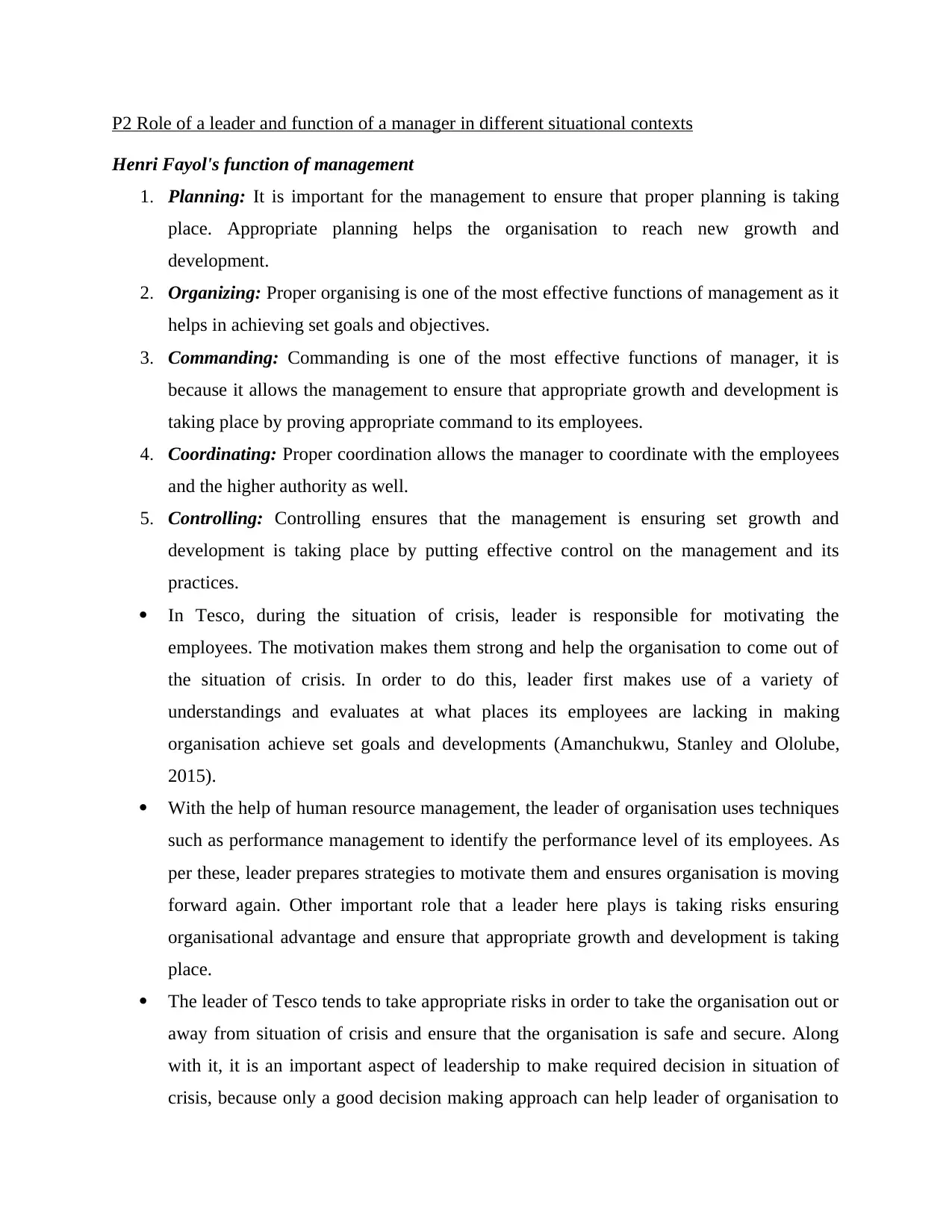
P2 Role of a leader and function of a manager in different situational contexts
Henri Fayol's function of management
1. Planning: It is important for the management to ensure that proper planning is taking
place. Appropriate planning helps the organisation to reach new growth and
development.
2. Organizing: Proper organising is one of the most effective functions of management as it
helps in achieving set goals and objectives.
3. Commanding: Commanding is one of the most effective functions of manager, it is
because it allows the management to ensure that appropriate growth and development is
taking place by proving appropriate command to its employees.
4. Coordinating: Proper coordination allows the manager to coordinate with the employees
and the higher authority as well.
5. Controlling: Controlling ensures that the management is ensuring set growth and
development is taking place by putting effective control on the management and its
practices.
In Tesco, during the situation of crisis, leader is responsible for motivating the
employees. The motivation makes them strong and help the organisation to come out of
the situation of crisis. In order to do this, leader first makes use of a variety of
understandings and evaluates at what places its employees are lacking in making
organisation achieve set goals and developments (Amanchukwu, Stanley and Ololube,
2015).
With the help of human resource management, the leader of organisation uses techniques
such as performance management to identify the performance level of its employees. As
per these, leader prepares strategies to motivate them and ensures organisation is moving
forward again. Other important role that a leader here plays is taking risks ensuring
organisational advantage and ensure that appropriate growth and development is taking
place.
The leader of Tesco tends to take appropriate risks in order to take the organisation out or
away from situation of crisis and ensure that the organisation is safe and secure. Along
with it, it is an important aspect of leadership to make required decision in situation of
crisis, because only a good decision making approach can help leader of organisation to
Henri Fayol's function of management
1. Planning: It is important for the management to ensure that proper planning is taking
place. Appropriate planning helps the organisation to reach new growth and
development.
2. Organizing: Proper organising is one of the most effective functions of management as it
helps in achieving set goals and objectives.
3. Commanding: Commanding is one of the most effective functions of manager, it is
because it allows the management to ensure that appropriate growth and development is
taking place by proving appropriate command to its employees.
4. Coordinating: Proper coordination allows the manager to coordinate with the employees
and the higher authority as well.
5. Controlling: Controlling ensures that the management is ensuring set growth and
development is taking place by putting effective control on the management and its
practices.
In Tesco, during the situation of crisis, leader is responsible for motivating the
employees. The motivation makes them strong and help the organisation to come out of
the situation of crisis. In order to do this, leader first makes use of a variety of
understandings and evaluates at what places its employees are lacking in making
organisation achieve set goals and developments (Amanchukwu, Stanley and Ololube,
2015).
With the help of human resource management, the leader of organisation uses techniques
such as performance management to identify the performance level of its employees. As
per these, leader prepares strategies to motivate them and ensures organisation is moving
forward again. Other important role that a leader here plays is taking risks ensuring
organisational advantage and ensure that appropriate growth and development is taking
place.
The leader of Tesco tends to take appropriate risks in order to take the organisation out or
away from situation of crisis and ensure that the organisation is safe and secure. Along
with it, it is an important aspect of leadership to make required decision in situation of
crisis, because only a good decision making approach can help leader of organisation to
⊘ This is a preview!⊘
Do you want full access?
Subscribe today to unlock all pages.

Trusted by 1+ million students worldwide
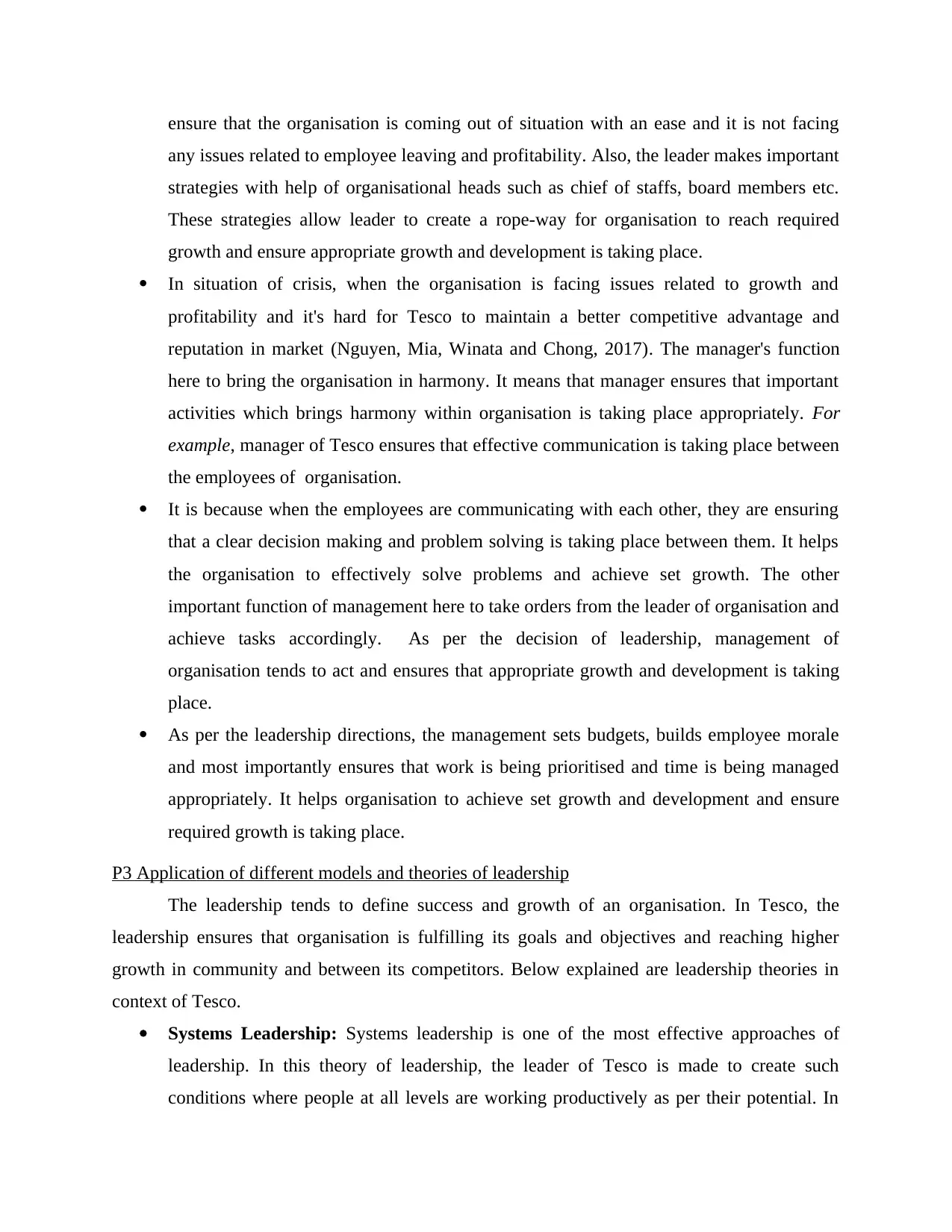
ensure that the organisation is coming out of situation with an ease and it is not facing
any issues related to employee leaving and profitability. Also, the leader makes important
strategies with help of organisational heads such as chief of staffs, board members etc.
These strategies allow leader to create a rope-way for organisation to reach required
growth and ensure appropriate growth and development is taking place.
In situation of crisis, when the organisation is facing issues related to growth and
profitability and it's hard for Tesco to maintain a better competitive advantage and
reputation in market (Nguyen, Mia, Winata and Chong, 2017). The manager's function
here to bring the organisation in harmony. It means that manager ensures that important
activities which brings harmony within organisation is taking place appropriately. For
example, manager of Tesco ensures that effective communication is taking place between
the employees of organisation.
It is because when the employees are communicating with each other, they are ensuring
that a clear decision making and problem solving is taking place between them. It helps
the organisation to effectively solve problems and achieve set growth. The other
important function of management here to take orders from the leader of organisation and
achieve tasks accordingly. As per the decision of leadership, management of
organisation tends to act and ensures that appropriate growth and development is taking
place.
As per the leadership directions, the management sets budgets, builds employee morale
and most importantly ensures that work is being prioritised and time is being managed
appropriately. It helps organisation to achieve set growth and development and ensure
required growth is taking place.
P3 Application of different models and theories of leadership
The leadership tends to define success and growth of an organisation. In Tesco, the
leadership ensures that organisation is fulfilling its goals and objectives and reaching higher
growth in community and between its competitors. Below explained are leadership theories in
context of Tesco.
Systems Leadership: Systems leadership is one of the most effective approaches of
leadership. In this theory of leadership, the leader of Tesco is made to create such
conditions where people at all levels are working productively as per their potential. In
any issues related to employee leaving and profitability. Also, the leader makes important
strategies with help of organisational heads such as chief of staffs, board members etc.
These strategies allow leader to create a rope-way for organisation to reach required
growth and ensure appropriate growth and development is taking place.
In situation of crisis, when the organisation is facing issues related to growth and
profitability and it's hard for Tesco to maintain a better competitive advantage and
reputation in market (Nguyen, Mia, Winata and Chong, 2017). The manager's function
here to bring the organisation in harmony. It means that manager ensures that important
activities which brings harmony within organisation is taking place appropriately. For
example, manager of Tesco ensures that effective communication is taking place between
the employees of organisation.
It is because when the employees are communicating with each other, they are ensuring
that a clear decision making and problem solving is taking place between them. It helps
the organisation to effectively solve problems and achieve set growth. The other
important function of management here to take orders from the leader of organisation and
achieve tasks accordingly. As per the decision of leadership, management of
organisation tends to act and ensures that appropriate growth and development is taking
place.
As per the leadership directions, the management sets budgets, builds employee morale
and most importantly ensures that work is being prioritised and time is being managed
appropriately. It helps organisation to achieve set growth and development and ensure
required growth is taking place.
P3 Application of different models and theories of leadership
The leadership tends to define success and growth of an organisation. In Tesco, the
leadership ensures that organisation is fulfilling its goals and objectives and reaching higher
growth in community and between its competitors. Below explained are leadership theories in
context of Tesco.
Systems Leadership: Systems leadership is one of the most effective approaches of
leadership. In this theory of leadership, the leader of Tesco is made to create such
conditions where people at all levels are working productively as per their potential. In
Paraphrase This Document
Need a fresh take? Get an instant paraphrase of this document with our AI Paraphraser
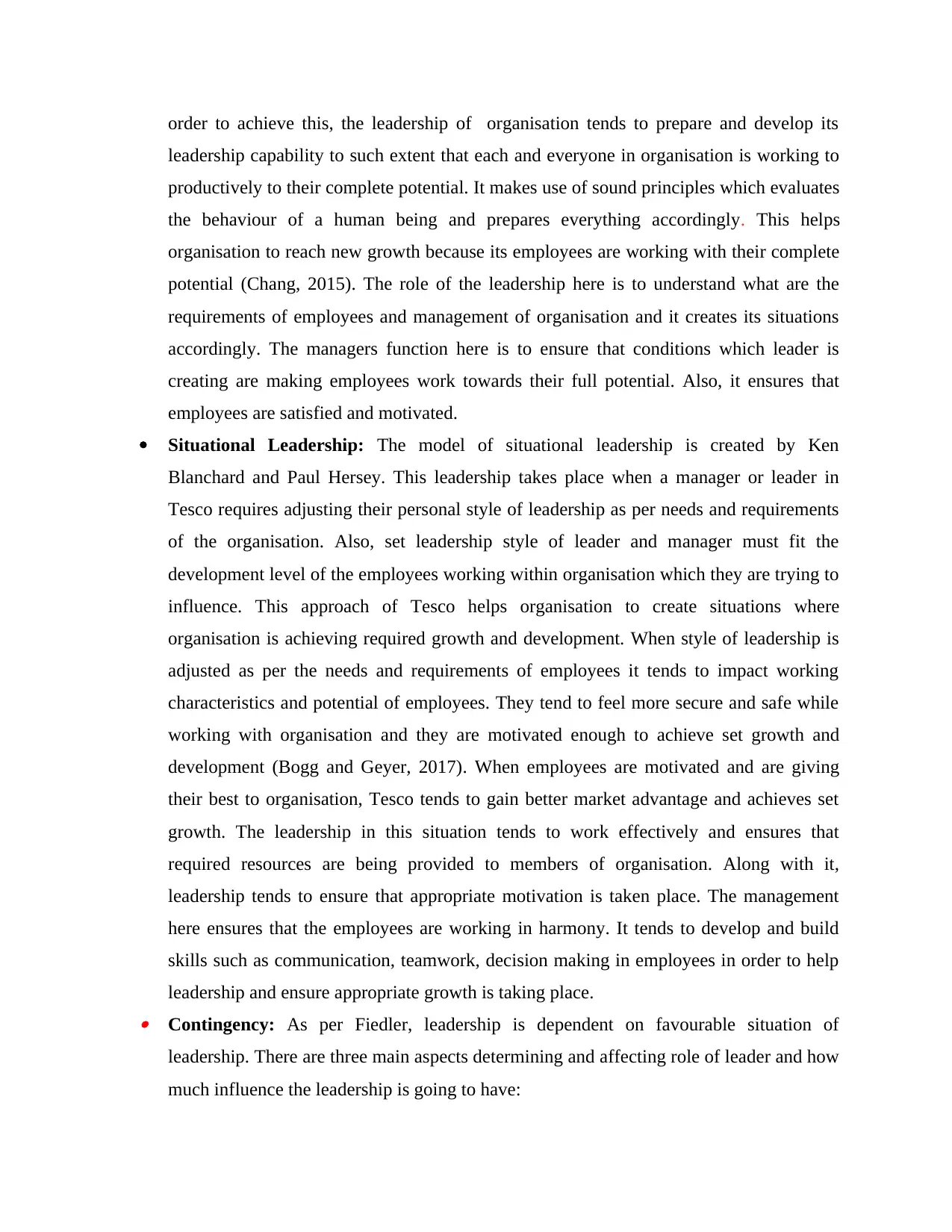
order to achieve this, the leadership of organisation tends to prepare and develop its
leadership capability to such extent that each and everyone in organisation is working to
productively to their complete potential. It makes use of sound principles which evaluates
the behaviour of a human being and prepares everything accordingly. This helps
organisation to reach new growth because its employees are working with their complete
potential (Chang, 2015). The role of the leadership here is to understand what are the
requirements of employees and management of organisation and it creates its situations
accordingly. The managers function here is to ensure that conditions which leader is
creating are making employees work towards their full potential. Also, it ensures that
employees are satisfied and motivated.
Situational Leadership: The model of situational leadership is created by Ken
Blanchard and Paul Hersey. This leadership takes place when a manager or leader in
Tesco requires adjusting their personal style of leadership as per needs and requirements
of the organisation. Also, set leadership style of leader and manager must fit the
development level of the employees working within organisation which they are trying to
influence. This approach of Tesco helps organisation to create situations where
organisation is achieving required growth and development. When style of leadership is
adjusted as per the needs and requirements of employees it tends to impact working
characteristics and potential of employees. They tend to feel more secure and safe while
working with organisation and they are motivated enough to achieve set growth and
development (Bogg and Geyer, 2017). When employees are motivated and are giving
their best to organisation, Tesco tends to gain better market advantage and achieves set
growth. The leadership in this situation tends to work effectively and ensures that
required resources are being provided to members of organisation. Along with it,
leadership tends to ensure that appropriate motivation is taken place. The management
here ensures that the employees are working in harmony. It tends to develop and build
skills such as communication, teamwork, decision making in employees in order to help
leadership and ensure appropriate growth is taking place. Contingency: As per Fiedler, leadership is dependent on favourable situation of
leadership. There are three main aspects determining and affecting role of leader and how
much influence the leadership is going to have:
leadership capability to such extent that each and everyone in organisation is working to
productively to their complete potential. It makes use of sound principles which evaluates
the behaviour of a human being and prepares everything accordingly. This helps
organisation to reach new growth because its employees are working with their complete
potential (Chang, 2015). The role of the leadership here is to understand what are the
requirements of employees and management of organisation and it creates its situations
accordingly. The managers function here is to ensure that conditions which leader is
creating are making employees work towards their full potential. Also, it ensures that
employees are satisfied and motivated.
Situational Leadership: The model of situational leadership is created by Ken
Blanchard and Paul Hersey. This leadership takes place when a manager or leader in
Tesco requires adjusting their personal style of leadership as per needs and requirements
of the organisation. Also, set leadership style of leader and manager must fit the
development level of the employees working within organisation which they are trying to
influence. This approach of Tesco helps organisation to create situations where
organisation is achieving required growth and development. When style of leadership is
adjusted as per the needs and requirements of employees it tends to impact working
characteristics and potential of employees. They tend to feel more secure and safe while
working with organisation and they are motivated enough to achieve set growth and
development (Bogg and Geyer, 2017). When employees are motivated and are giving
their best to organisation, Tesco tends to gain better market advantage and achieves set
growth. The leadership in this situation tends to work effectively and ensures that
required resources are being provided to members of organisation. Along with it,
leadership tends to ensure that appropriate motivation is taken place. The management
here ensures that the employees are working in harmony. It tends to develop and build
skills such as communication, teamwork, decision making in employees in order to help
leadership and ensure appropriate growth is taking place. Contingency: As per Fiedler, leadership is dependent on favourable situation of
leadership. There are three main aspects determining and affecting role of leader and how
much influence the leadership is going to have:
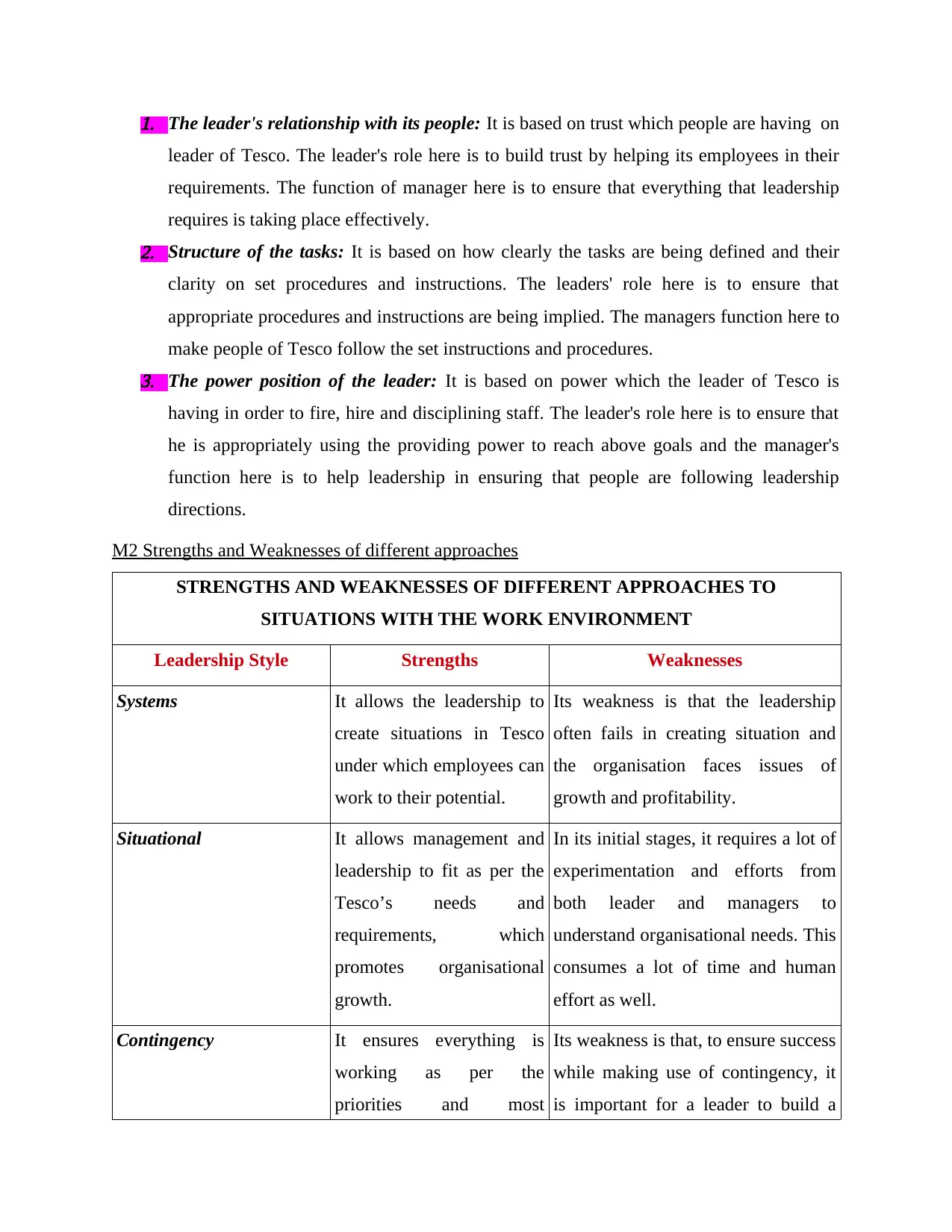
1. The leader's relationship with its people: It is based on trust which people are having on
leader of Tesco. The leader's role here is to build trust by helping its employees in their
requirements. The function of manager here is to ensure that everything that leadership
requires is taking place effectively.2. Structure of the tasks: It is based on how clearly the tasks are being defined and their
clarity on set procedures and instructions. The leaders' role here is to ensure that
appropriate procedures and instructions are being implied. The managers function here to
make people of Tesco follow the set instructions and procedures.3. The power position of the leader: It is based on power which the leader of Tesco is
having in order to fire, hire and disciplining staff. The leader's role here is to ensure that
he is appropriately using the providing power to reach above goals and the manager's
function here is to help leadership in ensuring that people are following leadership
directions.
M2 Strengths and Weaknesses of different approaches
STRENGTHS AND WEAKNESSES OF DIFFERENT APPROACHES TO
SITUATIONS WITH THE WORK ENVIRONMENT
Leadership Style Strengths Weaknesses
Systems It allows the leadership to
create situations in Tesco
under which employees can
work to their potential.
Its weakness is that the leadership
often fails in creating situation and
the organisation faces issues of
growth and profitability.
Situational It allows management and
leadership to fit as per the
Tesco’s needs and
requirements, which
promotes organisational
growth.
In its initial stages, it requires a lot of
experimentation and efforts from
both leader and managers to
understand organisational needs. This
consumes a lot of time and human
effort as well.
Contingency It ensures everything is
working as per the
priorities and most
Its weakness is that, to ensure success
while making use of contingency, it
is important for a leader to build a
leader of Tesco. The leader's role here is to build trust by helping its employees in their
requirements. The function of manager here is to ensure that everything that leadership
requires is taking place effectively.2. Structure of the tasks: It is based on how clearly the tasks are being defined and their
clarity on set procedures and instructions. The leaders' role here is to ensure that
appropriate procedures and instructions are being implied. The managers function here to
make people of Tesco follow the set instructions and procedures.3. The power position of the leader: It is based on power which the leader of Tesco is
having in order to fire, hire and disciplining staff. The leader's role here is to ensure that
he is appropriately using the providing power to reach above goals and the manager's
function here is to help leadership in ensuring that people are following leadership
directions.
M2 Strengths and Weaknesses of different approaches
STRENGTHS AND WEAKNESSES OF DIFFERENT APPROACHES TO
SITUATIONS WITH THE WORK ENVIRONMENT
Leadership Style Strengths Weaknesses
Systems It allows the leadership to
create situations in Tesco
under which employees can
work to their potential.
Its weakness is that the leadership
often fails in creating situation and
the organisation faces issues of
growth and profitability.
Situational It allows management and
leadership to fit as per the
Tesco’s needs and
requirements, which
promotes organisational
growth.
In its initial stages, it requires a lot of
experimentation and efforts from
both leader and managers to
understand organisational needs. This
consumes a lot of time and human
effort as well.
Contingency It ensures everything is
working as per the
priorities and most
Its weakness is that, to ensure success
while making use of contingency, it
is important for a leader to build a
⊘ This is a preview!⊘
Do you want full access?
Subscribe today to unlock all pages.

Trusted by 1+ million students worldwide
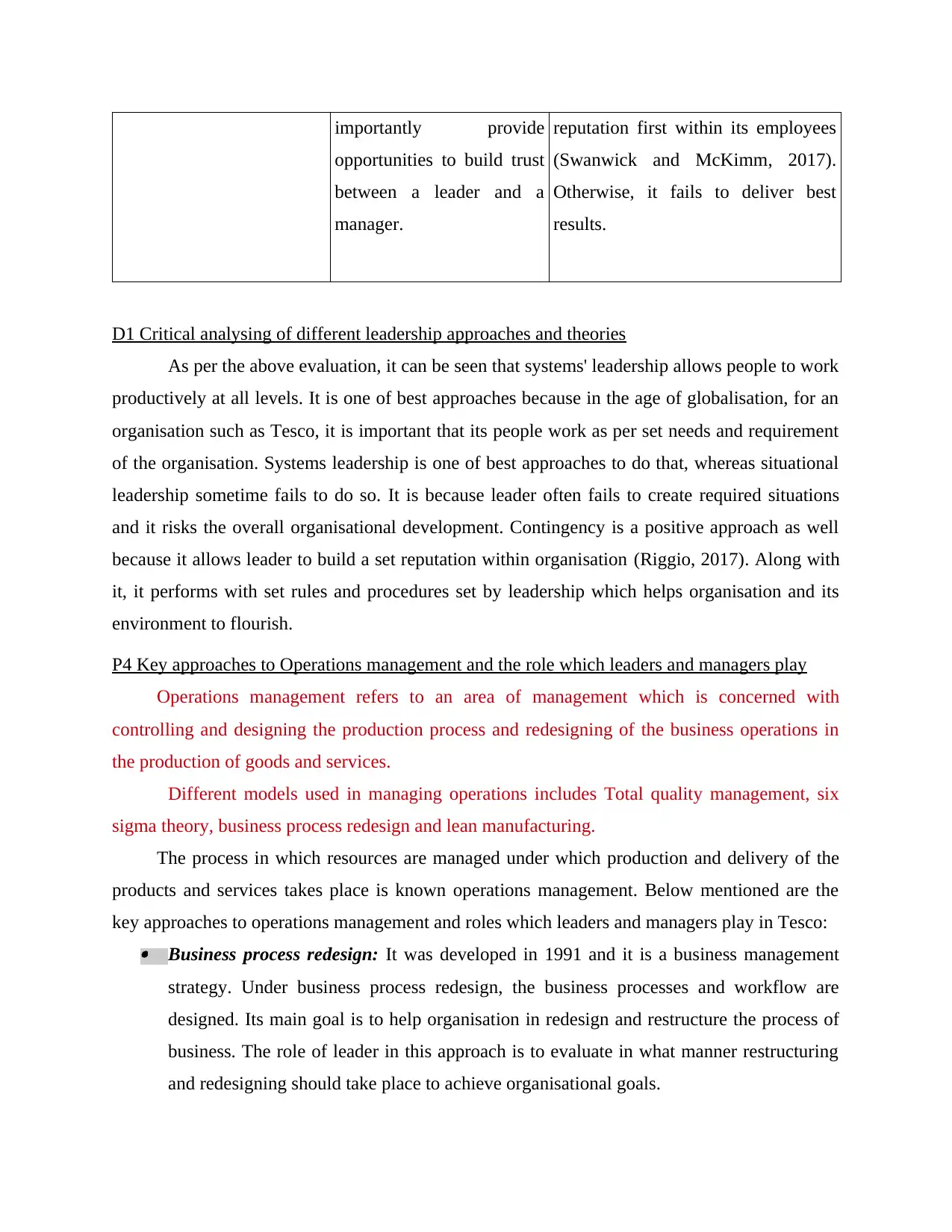
importantly provide
opportunities to build trust
between a leader and a
manager.
reputation first within its employees
(Swanwick and McKimm, 2017).
Otherwise, it fails to deliver best
results.
D1 Critical analysing of different leadership approaches and theories
As per the above evaluation, it can be seen that systems' leadership allows people to work
productively at all levels. It is one of best approaches because in the age of globalisation, for an
organisation such as Tesco, it is important that its people work as per set needs and requirement
of the organisation. Systems leadership is one of best approaches to do that, whereas situational
leadership sometime fails to do so. It is because leader often fails to create required situations
and it risks the overall organisational development. Contingency is a positive approach as well
because it allows leader to build a set reputation within organisation (Riggio, 2017). Along with
it, it performs with set rules and procedures set by leadership which helps organisation and its
environment to flourish.
P4 Key approaches to Operations management and the role which leaders and managers play
Operations management refers to an area of management which is concerned with
controlling and designing the production process and redesigning of the business operations in
the production of goods and services.
Different models used in managing operations includes Total quality management, six
sigma theory, business process redesign and lean manufacturing.
The process in which resources are managed under which production and delivery of the
products and services takes place is known operations management. Below mentioned are the
key approaches to operations management and roles which leaders and managers play in Tesco: Business process redesign: It was developed in 1991 and it is a business management
strategy. Under business process redesign, the business processes and workflow are
designed. Its main goal is to help organisation in redesign and restructure the process of
business. The role of leader in this approach is to evaluate in what manner restructuring
and redesigning should take place to achieve organisational goals.
opportunities to build trust
between a leader and a
manager.
reputation first within its employees
(Swanwick and McKimm, 2017).
Otherwise, it fails to deliver best
results.
D1 Critical analysing of different leadership approaches and theories
As per the above evaluation, it can be seen that systems' leadership allows people to work
productively at all levels. It is one of best approaches because in the age of globalisation, for an
organisation such as Tesco, it is important that its people work as per set needs and requirement
of the organisation. Systems leadership is one of best approaches to do that, whereas situational
leadership sometime fails to do so. It is because leader often fails to create required situations
and it risks the overall organisational development. Contingency is a positive approach as well
because it allows leader to build a set reputation within organisation (Riggio, 2017). Along with
it, it performs with set rules and procedures set by leadership which helps organisation and its
environment to flourish.
P4 Key approaches to Operations management and the role which leaders and managers play
Operations management refers to an area of management which is concerned with
controlling and designing the production process and redesigning of the business operations in
the production of goods and services.
Different models used in managing operations includes Total quality management, six
sigma theory, business process redesign and lean manufacturing.
The process in which resources are managed under which production and delivery of the
products and services takes place is known operations management. Below mentioned are the
key approaches to operations management and roles which leaders and managers play in Tesco: Business process redesign: It was developed in 1991 and it is a business management
strategy. Under business process redesign, the business processes and workflow are
designed. Its main goal is to help organisation in redesign and restructure the process of
business. The role of leader in this approach is to evaluate in what manner restructuring
and redesigning should take place to achieve organisational goals.
Paraphrase This Document
Need a fresh take? Get an instant paraphrase of this document with our AI Paraphraser
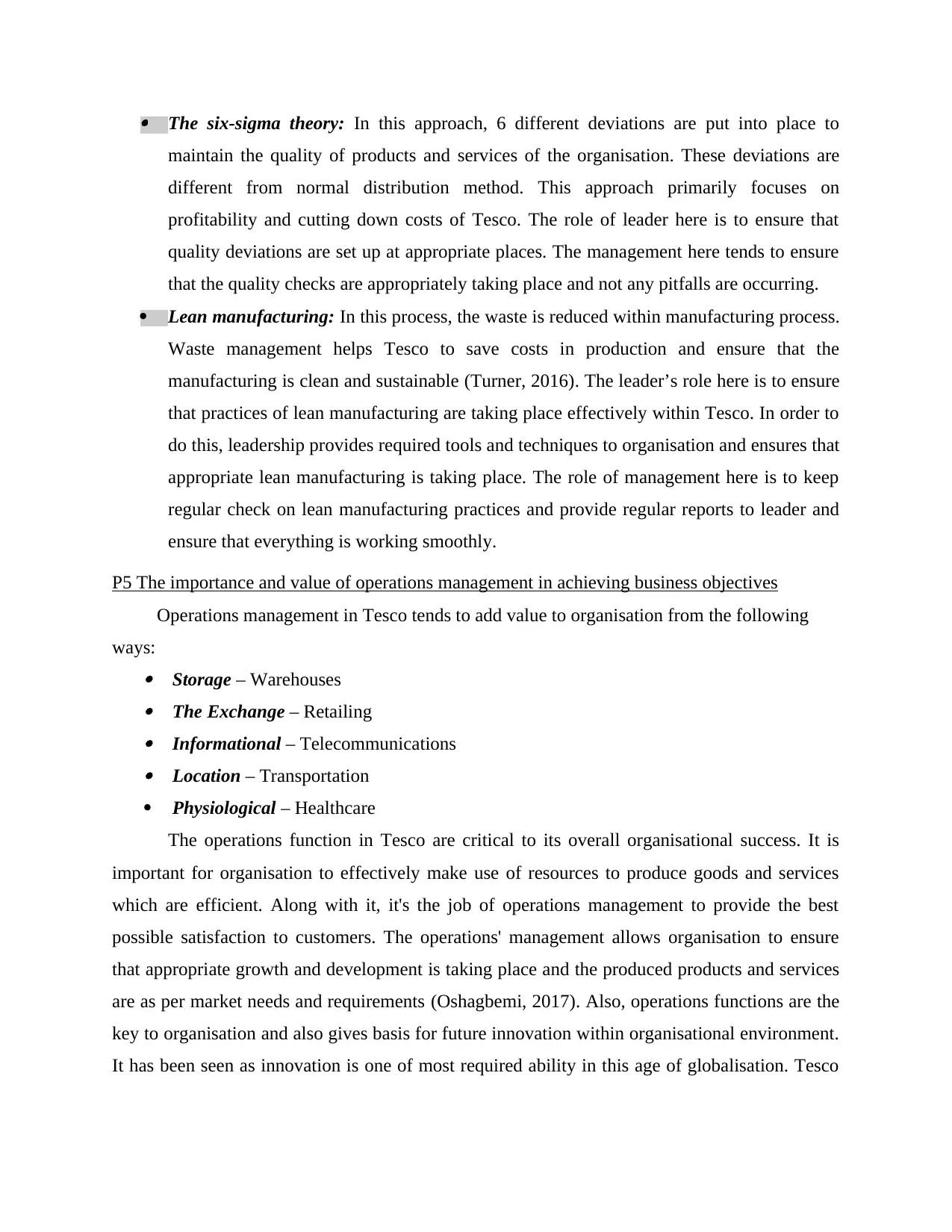
The six-sigma theory: In this approach, 6 different deviations are put into place to
maintain the quality of products and services of the organisation. These deviations are
different from normal distribution method. This approach primarily focuses on
profitability and cutting down costs of Tesco. The role of leader here is to ensure that
quality deviations are set up at appropriate places. The management here tends to ensure
that the quality checks are appropriately taking place and not any pitfalls are occurring.
Lean manufacturing: In this process, the waste is reduced within manufacturing process.
Waste management helps Tesco to save costs in production and ensure that the
manufacturing is clean and sustainable (Turner, 2016). The leader’s role here is to ensure
that practices of lean manufacturing are taking place effectively within Tesco. In order to
do this, leadership provides required tools and techniques to organisation and ensures that
appropriate lean manufacturing is taking place. The role of management here is to keep
regular check on lean manufacturing practices and provide regular reports to leader and
ensure that everything is working smoothly.
P5 The importance and value of operations management in achieving business objectives
Operations management in Tesco tends to add value to organisation from the following
ways: Storage – Warehouses The Exchange – Retailing Informational – Telecommunications Location – Transportation
Physiological – Healthcare
The operations function in Tesco are critical to its overall organisational success. It is
important for organisation to effectively make use of resources to produce goods and services
which are efficient. Along with it, it's the job of operations management to provide the best
possible satisfaction to customers. The operations' management allows organisation to ensure
that appropriate growth and development is taking place and the produced products and services
are as per market needs and requirements (Oshagbemi, 2017). Also, operations functions are the
key to organisation and also gives basis for future innovation within organisational environment.
It has been seen as innovation is one of most required ability in this age of globalisation. Tesco
maintain the quality of products and services of the organisation. These deviations are
different from normal distribution method. This approach primarily focuses on
profitability and cutting down costs of Tesco. The role of leader here is to ensure that
quality deviations are set up at appropriate places. The management here tends to ensure
that the quality checks are appropriately taking place and not any pitfalls are occurring.
Lean manufacturing: In this process, the waste is reduced within manufacturing process.
Waste management helps Tesco to save costs in production and ensure that the
manufacturing is clean and sustainable (Turner, 2016). The leader’s role here is to ensure
that practices of lean manufacturing are taking place effectively within Tesco. In order to
do this, leadership provides required tools and techniques to organisation and ensures that
appropriate lean manufacturing is taking place. The role of management here is to keep
regular check on lean manufacturing practices and provide regular reports to leader and
ensure that everything is working smoothly.
P5 The importance and value of operations management in achieving business objectives
Operations management in Tesco tends to add value to organisation from the following
ways: Storage – Warehouses The Exchange – Retailing Informational – Telecommunications Location – Transportation
Physiological – Healthcare
The operations function in Tesco are critical to its overall organisational success. It is
important for organisation to effectively make use of resources to produce goods and services
which are efficient. Along with it, it's the job of operations management to provide the best
possible satisfaction to customers. The operations' management allows organisation to ensure
that appropriate growth and development is taking place and the produced products and services
are as per market needs and requirements (Oshagbemi, 2017). Also, operations functions are the
key to organisation and also gives basis for future innovation within organisational environment.
It has been seen as innovation is one of most required ability in this age of globalisation. Tesco
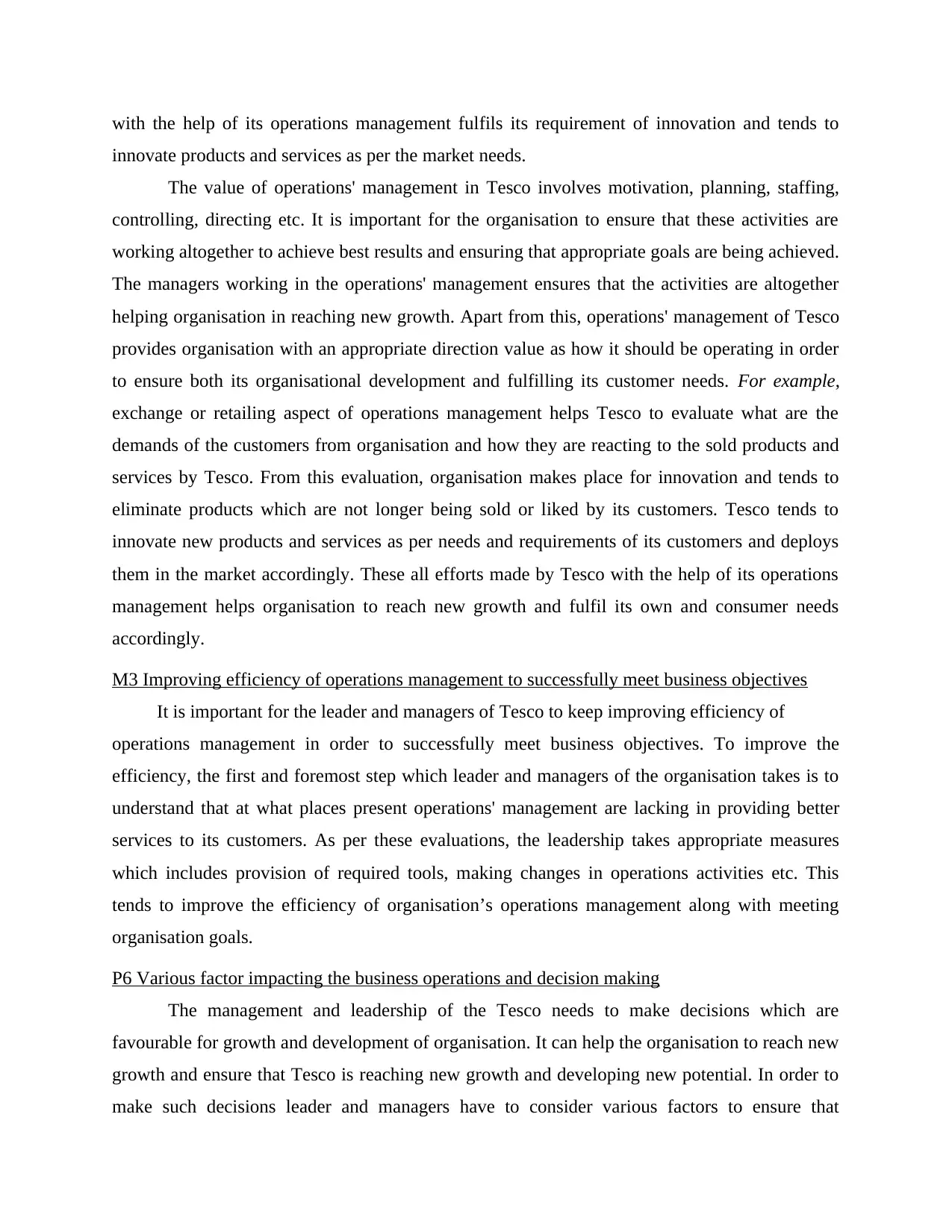
with the help of its operations management fulfils its requirement of innovation and tends to
innovate products and services as per the market needs.
The value of operations' management in Tesco involves motivation, planning, staffing,
controlling, directing etc. It is important for the organisation to ensure that these activities are
working altogether to achieve best results and ensuring that appropriate goals are being achieved.
The managers working in the operations' management ensures that the activities are altogether
helping organisation in reaching new growth. Apart from this, operations' management of Tesco
provides organisation with an appropriate direction value as how it should be operating in order
to ensure both its organisational development and fulfilling its customer needs. For example,
exchange or retailing aspect of operations management helps Tesco to evaluate what are the
demands of the customers from organisation and how they are reacting to the sold products and
services by Tesco. From this evaluation, organisation makes place for innovation and tends to
eliminate products which are not longer being sold or liked by its customers. Tesco tends to
innovate new products and services as per needs and requirements of its customers and deploys
them in the market accordingly. These all efforts made by Tesco with the help of its operations
management helps organisation to reach new growth and fulfil its own and consumer needs
accordingly.
M3 Improving efficiency of operations management to successfully meet business objectives
It is important for the leader and managers of Tesco to keep improving efficiency of
operations management in order to successfully meet business objectives. To improve the
efficiency, the first and foremost step which leader and managers of the organisation takes is to
understand that at what places present operations' management are lacking in providing better
services to its customers. As per these evaluations, the leadership takes appropriate measures
which includes provision of required tools, making changes in operations activities etc. This
tends to improve the efficiency of organisation’s operations management along with meeting
organisation goals.
P6 Various factor impacting the business operations and decision making
The management and leadership of the Tesco needs to make decisions which are
favourable for growth and development of organisation. It can help the organisation to reach new
growth and ensure that Tesco is reaching new growth and developing new potential. In order to
make such decisions leader and managers have to consider various factors to ensure that
innovate products and services as per the market needs.
The value of operations' management in Tesco involves motivation, planning, staffing,
controlling, directing etc. It is important for the organisation to ensure that these activities are
working altogether to achieve best results and ensuring that appropriate goals are being achieved.
The managers working in the operations' management ensures that the activities are altogether
helping organisation in reaching new growth. Apart from this, operations' management of Tesco
provides organisation with an appropriate direction value as how it should be operating in order
to ensure both its organisational development and fulfilling its customer needs. For example,
exchange or retailing aspect of operations management helps Tesco to evaluate what are the
demands of the customers from organisation and how they are reacting to the sold products and
services by Tesco. From this evaluation, organisation makes place for innovation and tends to
eliminate products which are not longer being sold or liked by its customers. Tesco tends to
innovate new products and services as per needs and requirements of its customers and deploys
them in the market accordingly. These all efforts made by Tesco with the help of its operations
management helps organisation to reach new growth and fulfil its own and consumer needs
accordingly.
M3 Improving efficiency of operations management to successfully meet business objectives
It is important for the leader and managers of Tesco to keep improving efficiency of
operations management in order to successfully meet business objectives. To improve the
efficiency, the first and foremost step which leader and managers of the organisation takes is to
understand that at what places present operations' management are lacking in providing better
services to its customers. As per these evaluations, the leadership takes appropriate measures
which includes provision of required tools, making changes in operations activities etc. This
tends to improve the efficiency of organisation’s operations management along with meeting
organisation goals.
P6 Various factor impacting the business operations and decision making
The management and leadership of the Tesco needs to make decisions which are
favourable for growth and development of organisation. It can help the organisation to reach new
growth and ensure that Tesco is reaching new growth and developing new potential. In order to
make such decisions leader and managers have to consider various factors to ensure that
⊘ This is a preview!⊘
Do you want full access?
Subscribe today to unlock all pages.

Trusted by 1+ million students worldwide
1 out of 16
Related Documents
Your All-in-One AI-Powered Toolkit for Academic Success.
+13062052269
info@desklib.com
Available 24*7 on WhatsApp / Email
![[object Object]](/_next/static/media/star-bottom.7253800d.svg)
Unlock your academic potential
Copyright © 2020–2025 A2Z Services. All Rights Reserved. Developed and managed by ZUCOL.


